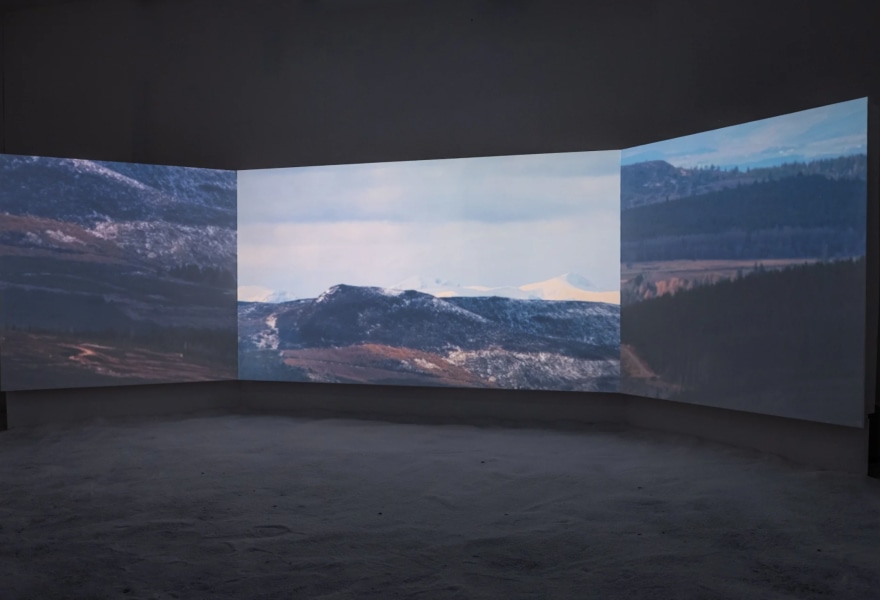07 september 2023, Indra Devriendt
En route
Lydia Hannah Debeer has taken over the gallery space at Fred&Ferry with her recent video works. A captivating feeling transcends the presence of image, sound and scenography. We feel immediately drawn to her work because it highlights a number of fundamental aspects of life.
Melting Mountains features footage from the Scottish Highlands. We see a triptych with vast, snowy mountain landscapes. Our footsteps creak, as when walking in snow, as we move through the gallery space. It is as if we are on our way to the landscape ourselves. Our gaze turns to breath-taking landscapes and soon transports us to the feeling these places evoke. Meanwhile, we hear piano music, singing or sound recordings from the landscape. These reinforce the formidable and fragile character of the mountain landscape. The subtle piano compositions are by Laurens Dierickx and the sensitive vocals by Lydia Hannah Debeer. Their rippling rhythm brings us to a halt, musing on the meaning of the lyrics. Subtle variations in sound and image create a level of suspense and hold our attention. For a moment, we forget everything around us. And when the credits appear, the realisation follows that it is (already) over.

Lydia Hannah Debeer, Of Salt and Skin, 2023, FRED&FERRY
Sound, vision and presentation all flow into each other. Debeer gives us a sense of how everything is connected and continuously subject to change. As the video recording progresses, we notice subtle changes. First, we imagine ourselves above cloud fields, viewing the mountaintops. Gradually, we see the mountains and finally, the images lead us to the tree line in the pine forest. The gradual reddening of the landscape also indicates the passage of time and melting snow the changing of seasons. The heat translates into vibrations in the air. Towards the end of the video recording, we notice how the sound of meltwater becomes ever more prominent.
Debeer only made static shots in the Scottish Highlands, but we also see movements through the landscape. “That happened by accident,” says Debeer. “When I zoomed in on a video still, I noticed that the movement produced a fascinating image. I took screenshots while digitally scrolling through the landscape of my shots. This creates a new form of appreciation. I look for tension and find it in the balance between the harmony of the landscapes and digital movement.”

Lydia Hannah Debeer, Shedding Skin, 2023, FRED&FERRY
“The physical effect of nature fascinates me,” says Debeer. “I'm looking for how I can use images of landscapes to create an atmosphere that triggers something. Experience is central to her work. It is so striking and confrontational because it points out things that are so typical of our existence. We think and feel in polarities. We experience something because we know the opposite. That creates a field of tension, which Debeer explores in her work. Life is changeability and continuous movement from one thing to another. “You can't hold on to anything,” says Debeer. “The realisation of how temporary everything is fascinates me. I create space for that change. A moment in the movement between where we were and where we are going.”

Lydia Hannah Debeer, Witness of Water, 2023, FRED&FERRY
Shedding Skin is also the title of the exhibition, referring to the transformation from old to new. Debeer looks for transitional phases. Where are they located and is it possible to capture them? “The psychotherapist Julia Samuel calls it the ‘fertile void’,” says Debeer. “That emptiness contains both construction and destruction. Take, for example, the transition from caterpillar to butterfly. This transformation takes place in the cocoon. Even if you were to open the cocoon, you would never see that intermediate stage. Rebecca Solnit describes that same feeling in her book A Field Guide to Getting Lost. She talks about her fascination with the blue at the very edge of what is visible. The colour of everything that is far away, such as the horizon or distant mountain ranges. The colour of that distance is the colour of an emotion, the colour of loneliness and longing. The colour of where you are not and where you can never go. Because the blue is not found miles away on the horizon, but in the atmospheric distance between you and the mountains. Being on the road to something keeps me busy. You can look back on change, but you can also look ahead or hope for what may yet come. Both points of view interest me. Nothing stays the same and that motivates me to keep working.”
